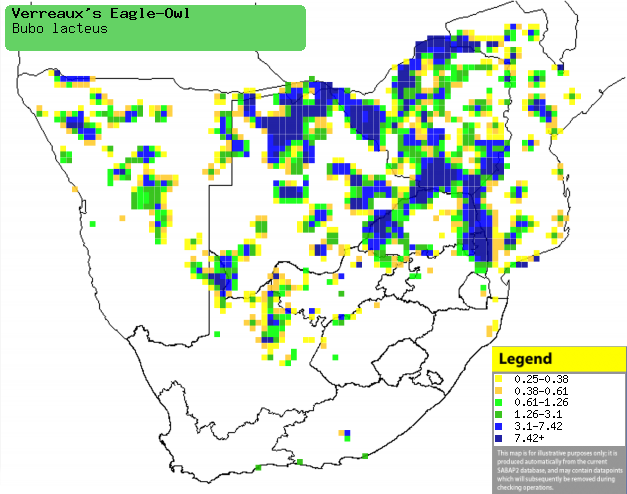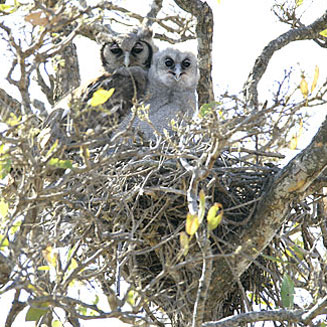|
Bubo lacteus (Verreaux's
eagle-owl, Giant eagle owl)
Reuse ooruil [Afrikaans]; Reuse-ooruil [Afrikaans];
Ifubesi (also applied to Spotted eagle owl) [Xhosa]; iFubesi, isiKhova [Zulu];
Editika (generic term for eagle owl) [Kwangali]; Zizi (generic name for owl)
[Shona]; Nkhunsi [Tsonga]; Makgotlwê, Mophoê, Morubise (these terms also
applied to Spotted eagle-owl) [Tswana]; Verreaux-oehoe [Dutch]; Grand-duc de
Verreaux [French]; Milchuhu, Blaßuhu [German]; Bufo-leitoso [Portuguese]
Life
> Eukaryotes >
Opisthokonta
> Metazoa (animals) >
Bilateria >
Deuterostomia > Chordata >
Craniata > Vertebrata (vertebrates) > Gnathostomata (jawed
vertebrates) > Teleostomi (teleost fish) > Osteichthyes (bony fish) > Class:
Sarcopterygii (lobe-finned
fish) > Stegocephalia (terrestrial
vertebrates) > Tetrapoda
(four-legged vertebrates) > Reptiliomorpha > Amniota >
Reptilia (reptiles) >
Romeriida > Diapsida > Archosauromorpha > Archosauria >
Dinosauria
(dinosaurs) > Saurischia > Theropoda (bipedal predatory dinosaurs) >
Coelurosauria > Maniraptora > Aves
(birds) >
Order: Strigiformes
> Family: Strigidae
The Verreaux's eagle-owl occurs across sub-Saharan Africa,
mainly occupying arid savanna and forest. It mainly eats mammals and birds,
including large species such as the Pel's fishing
owl. It is an extremely agile hunter for its size, and can actually catch
smaller birds in flight! It uses stick nests constructed by other birds, such as
weavers, crows and raptors. Here it lays 2 eggs, which are incubated solely by
the female, for about 38-39 days, who is fed at night by the male. Of the two
chicks only one survives, the other obtains less food from its parents, and
usually dies of starvation after 2-3 weeks. The surviving chick stays in the
nest for about 2 months, after which he remains dependent on his parents for 1-2
more years.
Distribution and habitat
Occurs in sub-Saharan Africa, excluding lowland equatorial
forest. In southern Africa it is locally common in northern and central Namibia,
Botswana, Zimbabwe, Mozambique and northern South Africa. It generally prefers arid savanna
and woodland, especially riverine
forest, occasionally moving into open areas such as grassland.
|
 |
|
Distribution of Verraux's eagle-owl in southern Africa,
based on statistical smoothing of the records from first SA Bird Atlas
Project (©
Animal Demography unit, University of
Cape Town; smoothing by Birgit Erni and Francesca Little). Colours range
from dark blue (most common) through to yellow (least common).
See here for the latest distribution
from the SABAP2. |
Food
Its diet consists of a wide variety of animals, most of
which are vertebrates such as mammals and birds. It
usually hunts at night, sitting on a perch in the open and searching for prey. Once
it spots something it rapidly glides down to the ground, attempting to grab the
prey item with its talons. If it fails to catch anything, it often stays on the
ground, trying to flush the animal out of its hiding place. It is
extremely agile on the wing, and can actually catch small birds in flight! The
following food items have been recorded in its diet:
- Vertebrates
- Mammals
- Birds
- reptiles
- amphibians
- Invertebrates
Breeding
- Usually uses stick nests constructed by other
birds, such as Sociable weavers,
Red-billed buffalo weavers,
Hamerkops,
Secretarybirds
and especially raptors, ranging from
the small nests of goshawks to the large platforms constructed by eagles or
vultures. It also occasionally uses tree cavities, as well as nests in
tangles of creepers and orchids.
 |
|
|
Verraux's eagle-owl at its nest with chick,
Central Kruger Park, South Africa. [photo
Warwick Tarboton ©] |
|
- Egg-laying season is from roughly May-October, peaking from
June-September.
- It usually lays two eggs, one of which is slightly smaller than the other.
They are incubated solely by the female for about 38-39 days, while the male
feeds her at night.
- Of the two chicks only one survives, as the other obtains less food from
its parents and usually dies of starvation after 2-3 weeks. The surviving
chick stays in the nest for about 62-63 days, taking its first flight a few
months later. It usually remains in its parents territory for a year before
becoming independent, however some fledglings remain with their parents for
another year, to help them raise the next chick.
Threats
Not officially threatened, however it might be vulnerable
due to its low population density and reproductive rate.
References
-
Hockey PAR, Dean WRJ and Ryan PG (eds) 2005. Roberts
- Birds of southern Africa, VIIth ed. The Trustees of the John Voelcker
Bird Book Fund, Cape Town.
|
